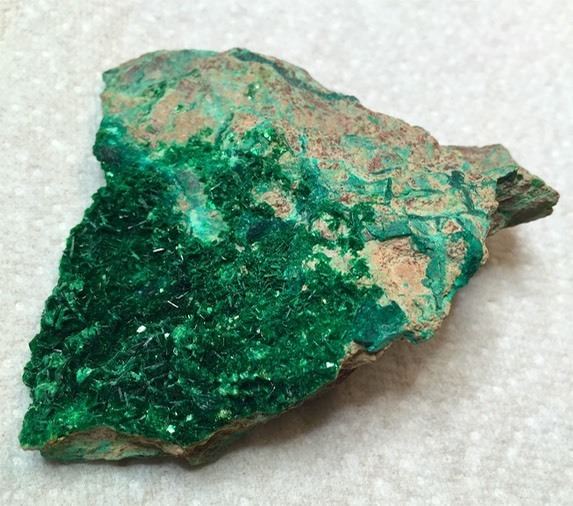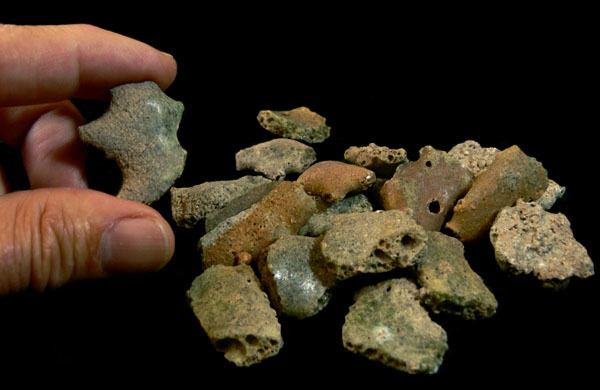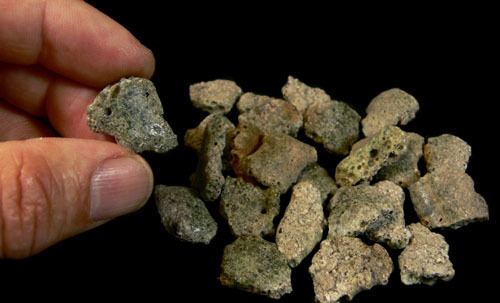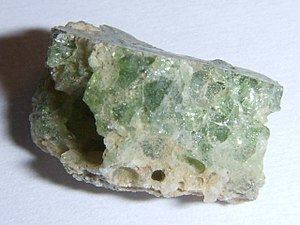 | ||
trinitite nuclear glass
Trinitite, also known as atomsite or Alamogordo glass, is the glassy residue left on the desert floor after the plutonium-based Trinity nuclear bomb test on July 16, 1945, near Alamogordo, New Mexico. The glass is primarily composed of arkosic sand composed of quartz grains and feldspar (both microcline and smaller amount of plagioclase with small amount of calcite, hornblende and augite in a matrix of sandy clay) that was melted by the atomic blast. It is usually a light green, although color can vary. It is mildly radioactive but safe to handle.
Contents
- trinitite nuclear glass
- Radioactivity of trinitite
- Formation
- Fake trinitite
- Trinitite type minerals
- Kharitonchik
- Trinitite like minerals
- Fulgurites
- Impact glasses
- Jewelry and radiation hazard
- References

In the late 1940s and early 1950s, samples were gathered and sold to mineral collectors as a novelty. Traces of the material may be found at the Trinity Site today, although most of it was bulldozed and buried by the United States Atomic Energy Commission in 1953. It is now illegal to take the remaining material from the site; however, material that was taken prior to this prohibition is still in the hands of collectors.

Radioactivity of trinitite
Formation

In 2005 it was theorized by Los Alamos National Laboratory scientist Robert Hermes and independent investigator William Strickfaden that much of the mineral was formed by sand which was drawn up inside the fireball itself and then rained down in a liquid form. In a 2010 article in Geology Today, Nelson Eby of University of Massachusetts at Lowell and Robert Hermes described Trinitite:

Contained within the glass are melted bits of the first atomic bomb and the support structures and various radionuclides formed during the detonation. The glass itself is marvelously complex at the tens to hundreds of micrometre scale, and besides glasses of varying composition also contains unmelted quartz grains. Air transport of the melted material led to the formation of spheres and dumbbell shaped glass particles. Similar glasses are formed during all ground level nuclear detonations and contain forensic information that can be used to identify the atomic device.

The glass has been described as "a layer 1 to 2 centimeters thick, with the upper surface marked by a very thin sprinkling of dust which fell upon it while it was still molten. At the bottom is a thicker film of partially fused material, which grades into the soil from which it was derived. The color of the glass is a pale bottle green, and the material is extremely vesicular with the size of the bubbles ranging to nearly the full thickness of the specimen."
An estimated 4.3 × 1019 ergs or 4.3 × 1012 joules of heat energy went into forming the glass and as the temperature required to melt the sand into the glass form observed was about 1470 Celsius, this was the estimated minimum temperature the sand was exposed to.
One of the more unusual isotopes found in trinitite, although by no means unique as it may also have formed during the Joe-1 test, which was a partial to complete Soviet replica of the Trinity/Fat Man design, is a barium neutron activation product, the barium in the Trinity device coming from the slow explosive lens employed in the device, known as Baratol.
Fake trinitite
There are many known fakes in circulation among collectors. These fakes use a variety of means to achieve the glassy green silica look as well as mild radioactivity, however, only trinitite from a nuclear explosion will contain certain neutron activation products that are not found in naturally radioactive ores and minerals. Gamma spectroscopy can narrow down the potential nuclear explosions from which the material formed.
Trinitite-type minerals
Occasionally, the name trinitite is broadly applied to all glassy residues of nuclear bomb testing, not just the Trinity test.
Black vitreous fragments of fused sand that had been solidified by the heat of the explosion were described from French test site in Algeria (Reggane site).
Kharitonchik
Kharitonchiki (singular: kharitonchik [харитончик]) is an analog of trinitite found in Semipalatinsk Test Site in Kazakhstan at ground zeroes of Soviet atmospheric nuclear tests. Also generically called Kharitonchik. They are pieces of molten rock left at ground zeroes after Soviet atmospheric nuclear tests. This porous black material is named after one of the leading Russian nuclear weapons scientists, Yulii Borisovich Khariton.
Trinitite-like minerals
Trinitite has several similar naturally occurring minerals as it is itself a melt glass.
Fulgurites
While trinitite and similar materials are anthropogenic, fulgurites, found in many desert or other sandy regions, are naturally formed, hollow glass tubes composed of quartzose sand, silica, or soil generated by lightning strikes.
Impact glasses
A material similar to trinitite can be formed by meteor impacts, these are impact glasses.
Jewelry and radiation hazard
For a time it was believed that the desert sand had simply melted from the direct radiant thermal energy of the fireball and was not particularly dangerous. Thus it was marketed as suitable for use in jewelry in 1945.
